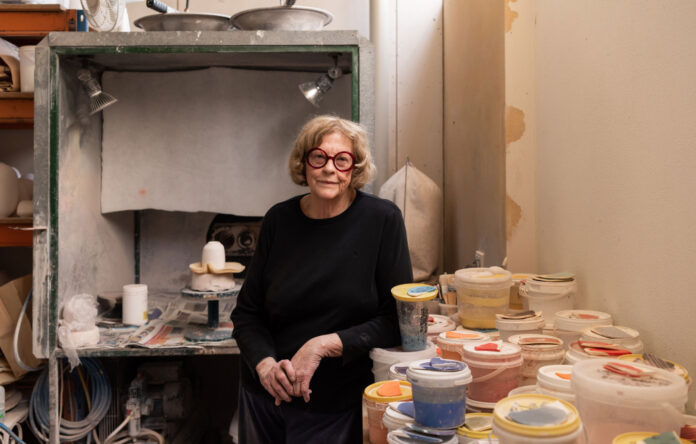[ad_1]
Inside The Fremantle Studio Of Legendary Ceramicist, Pippin Drysdale
Studio Visit

Pippin in her studio. Photo – Dion Robeson.

Unglazed forms and tiny scalpel blades. Photo – Dion Robeson.

Marking a clay body before its first glaze. Photo – Dion Robeson.

Pippin works from her home studio in Fremantle, surrounded by her tests and experiments. Photo – Dion Robeson.

Each form is hand-thrown by Pippin’s great friend and colleague, Warwick Palmateer, who has been working with her for 27 years. Photo – Dion Robeson.

A view from the storage room into the workshop. Photo – Dion Robeson.

The unglazed pots are stacked up on shelves beside a spraying booth where the glazes are applied. Photo – Dion Robeson.

A collection of finished works. Photo – Dion Robeson.

Pippin in front of her finished vessels, each of them unique in shape, colour and line decoration. Photo – Dion Robeson.

The complexity of colour and hue is on display in each individual piece and when they are collected en masse. Photo – Dion Robeson.

An art-filled corner of Pippin’s house. Photo – Dion Robeson.

A collection of treasures in the home that adjoins Pippin’s studio. Photo – Dion Robeson.

Vibrants reds, oranges and yellows dominate this colour collection in her new body of work for Linton + Kay. Photo – Courtesy of Linton + Kay.

The Patterning Of Light: Breakaway Series II, marks a shift in perspective for the artist from vast landscapes to minutiae of nature. Photo – Courtesy of Linton + Kay.
For the majority of her career, Pippin Drysdale’s inspiration has been the vast and sweeping Australian landscape.
She was 50 when she won an arts fellowship that took her to the centre of these remote deserts, traversing the Pilbara, Kimberley and Arnhem lands to visit the legendary Maningrida arts centre and artist communities on Melville Island. This trip would sustain her inspiration and work for decades.
‘So much of my journey has all developed into a thematic of traces, traces of time, linear lines, shadows, colour and big crops,’ Pippin explains.
These traces have marked themselves on her ceramics as linework, etched across each hand-thrown vessel, and handpainted in a contrasting hue. ‘The lines take on their own journey,’ she says, explaining the intricate network of rivulets for a single vessel surface can consume up to eight hours to complete. It’s worth it, however. The small incisions are her signature style, despite a shift in focus for her most recent body of work.
In her newest series, The Patterning Of Light: Breakaway Series II, Pippin moves ‘from the bigness of the landscape and the gorges and the breakaway country to the smallness of the flora and the fauna and the minute subtleties of the landscapes’.
Her process, however, has not changed.
To prepare the pieces for this exhibition, Pippin works in her studio at the back of her renovated cottage with a small team of artisans. Warwick Palmateer has been throwing clay forms with Pippin for 27 years, and has been instrumental in her experiments with new porcelain shapes.
To begin each work, Warwick passes the porcelain through a pug mill five times to increase its elasticity. He then throws the form on the pottery wheel, either creating a closed spherical sculpture or a wide-brimmed open vase. From here, he places the finished ball on a flat surface where it is turned, pressed and rolled into a wobbly orb.
Pippin herself then applies the glazes from a spray gun. Once these layers have dried, she takes a blade and makes incisions by hand, slowly sinking the scalpel into the clay body to form channels upon its surface. Later, this linework is filled with a new colour.
‘You just do this in sections at a time,’ Pippin says of the lengthy process. ‘And you allow these sections to just grow, incise and grow, and they take on their own form.’
Each piece is a one-off, the unique shapes made more so by the colours and cuts applied to the surface. After each shade is sprayed the body must be wiped and then sprayed again, just as each carved channel must be brushed out, marking the vessels with human touch and trace.
‘There’s so much intuition when you’re working with ceramics,’ explains Pippin. It’s taken her decades to refine her processes, testing and experimenting with different tools and techniques. ‘It’s taken me 20 years to work out to do it with a soft brush and pull the residue at the same time,’ she laughs.
But it’s paid off. This quiet yet mighty lifelong practice is a sublime secret tucked into the Fremantle suburbs!
The Patterning Of Light: Breakaway Series II will be on show at Linton + Kay until October 31st. See more about the exhibition here.
If you’re interested in learning more about Pippin’s work and process, watch the short video here.
[ad_2]
thedesignfiles.net










